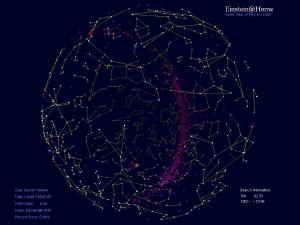Blog
Astronomy at Home
3 December 2013
 Einstein@Home
Einstein@HomeEinstein@Home is a distributed computing program you can download to your personal computer. It was originally intended to search through LIGO data for gravitational waves, but in 2009 it also began searching through radio data from Arecibo radio telescope to look for radio pulsars. While the LIGO data hasn’t yielded any gravitational waves, the radio data has detected more than 130 radio pulsars. These pulsars were previously known, but it demonstrated that distributed computing could be used to mine data.
Now a new paper in Astrophysical Journal Letters1 has shown Einstein@Home can be used to find new discoveries as well. The team used the distributed computing network to analyze x-ray data from the Fermi gamma ray telescope. From this they found four new gamma ray pulsars.
Most gamma ray pulsars are also radio pulsars. Since radio astronomy is easier than gamma ray astronomy, most gamma ray pulsars are first discovered at radio wavelengths and then demonstrated to be gamma ray pulsars as well. These new pulsars were discovered directly. What’s more, they are quiet at radio wavelengths, so they couldn’t have been discovered that way.
Not a bad way to use some volunteer computing resources. If you are interested in being a part of Einstein@Home, you can check out their website.
Pletsch, Holger J., et al. “Einstein@ Home discovery of four young gamma-ray pulsars in Fermi LAT data.” The Astrophysical Journal Letters 779.1 (2013): L11. ↩︎